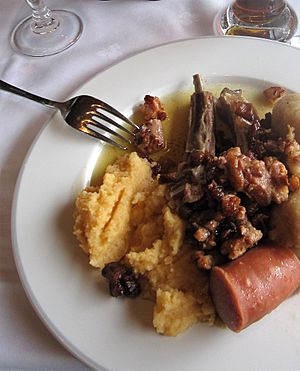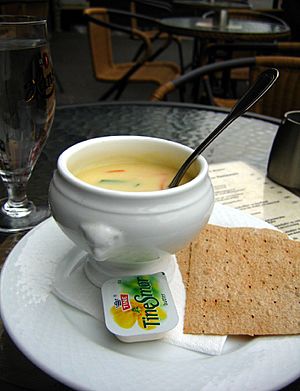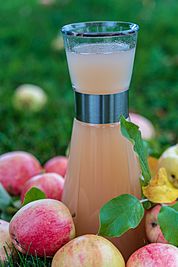List of Norwegian dishes facts for kids
Norwegian food is super interesting and tasty! It's often made with ingredients found right in Norway, like fresh fish from the coast, or game meat from the mountains and forests. Because winters used to be very long and cold, many traditional dishes were made with preserved foods. Norwegian food is a bit like what you'd find in other Scandinavian countries, but Norway has its own special dishes too. Let's explore some of them!
Contents
Breads and Pastries
Norwegians love their bread, and there are many different kinds!
- Arme riddere (Poor Knights) – This is Norway's version of French toast. It used to be a dessert, but now people often eat it for brunch or breakfast. It's usually spiced with cinnamon and cardamom.
- Rike riddere (Rich Knights) – A fancier French toast, often served with whipped cream, berries, jam, and nuts.
- Bolle – A small, round wheat bun. It's made with flour, sugar, yeast, eggs, milk, and often cardamom. Buns can have raisins (rosinbolle) or chocolate (sjokoladebolle). They are great with butter, as a snack, or with coffee.
- Flatbrød – A traditional Norwegian flatbread that doesn't use yeast. It's usually eaten with fish, salted meats, and soups. Long ago, it was a main food for farmers and shepherds. It's made from barley flour, salt, and water.
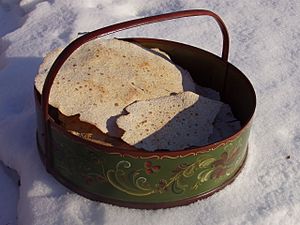
- Kneippbrød – This is a popular whole wheat bread in Norway.
- Knekkebrød – A flat, dry cracker, mostly made from rye flour. People often eat it for breakfast or lunch with cheese, cold meats, or other spreads.
- Lefse – A soft, traditional Norwegian flatbread. It's made with flour, sometimes potatoes, butter, and milk or cream. It's cooked on a big, flat griddle.
- Tynnlefse (thin lefse) – A thin version from central Norway. It's rolled up with butter, sugar, and cinnamon.
- Tjukklefse – A thicker lefse, often served with coffee like a cake.
- Potetlefse (potato lefse) – Similar to tynnlefse but made with potatoes.
- Lompe or potetkake – A smaller potato lefse, usually made with just boiled potatoes, flour, and salt. It's often used instead of a hot dog bun, especially on Norway's Constitution Day (May 17th). You can add ketchup, mustard, or other toppings.
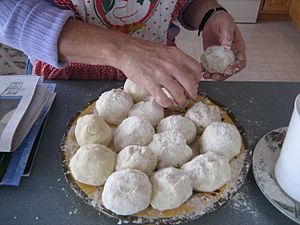
- Pannekake – Norwegian pancakes are like thin French crêpes. They can be sweet, with sugar, jam, or chocolate, or savory, served with bacon, jam, potatoes, or sour cream for dinner.
- Pinnebrød – (Stick bread) – This bread dough is rolled into a long sausage shape, twisted around a stick, and baked over an open fire. It's a fun campfire treat!
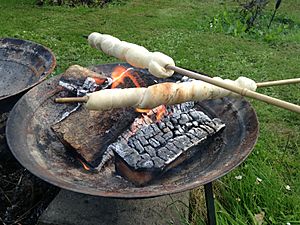
- Rugbrød – Rye bread, made with different amounts of rye flour. It can be light or dark and is usually denser than wheat bread.
- Rundstykke – A small, often round, bread roll served with meals, usually with butter or toppings.
- Smørbrød – A classic open-faced sandwich. It's a piece of buttered bread topped with cold cuts, meat, fish, cheese, or spreads, and garnishes.
- Rekesmørbrød – An open-faced sandwich with white bread, usually topped with mayonnaise, pepper, lemon juice, dill, and shrimp.
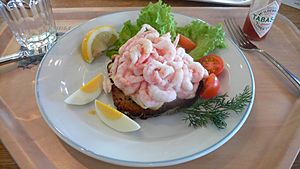
- Vaffel – Waffles are popular in Norway, especially on Constitution Day, birthdays, and holidays. They are served with jam, sour cream, or brunost (brown cheese).
- Svele – A batter-based cake, similar to a thick pancake. People often eat them for afternoon coffee or as a snack, served with butter and sugar or brunost, folded in half.
Meaty Meals
Meat dishes in Norway often use game or preserved meats, reflecting the country's history and nature.
- Fenalår – A traditional cured meat made from salted and dried lamb leg. It's often served with other preserved foods at Christmas or on Constitution Day.
- Finnbiff – Thinly sliced reindeer meat, fried and spiced with pepper and salt. Water, cream, or beer is added, and it's cooked until tender. Sometimes brown cheese is added. It's served with mashed potatoes and lingonberry jam.
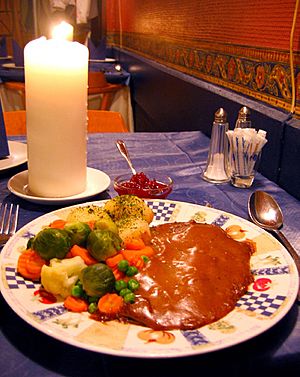
- Fårikål – This is Norway's national dish! It's made with pieces of mutton (lamb meat with bone), cabbage, whole black pepper, and sometimes a little wheat flour. It's cooked for several hours in a pot and traditionally served with potatoes boiled in their skins.
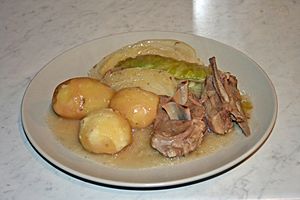
- Kjøttbolle – Smaller, round meatballs, often served with brown sauce, mashed potatoes, and lingonberry jam.
- Kjøttkake – Large meat patties made from ground beef, onion, salt, and pepper. They are usually served with brown sauce, potatoes, peas, carrots, and cabbage in cream sauce. Lingonberry jam is a common side.
- Lapskaus – A thick Norwegian stew made with meat and potatoes, often with vegetables like carrots, onions, and rutabaga.
- Leverpostei – A pâté (spread) made from finely ground pork liver and lard. It's often eaten on bread.

- Pinnekjøtt (Stick meat) – A festive lamb dish, steamed over sticks in a pot. It's a popular Christmas meal, often served with puréed rutabaga, sausages, and potatoes.
- Pølse i brød – A hot dog in a bread bun. It's a common food at big gatherings, birthdays, and on the national day. You can add raw or fried onions, ketchup, mustard, or potato salad.
- Sodd – A traditional Norwegian soup with cooked mutton and meatballs made from lamb or beef. It includes potatoes and carrots in a clear, flavorful broth.
- Spekemat – A general term for food preserved by curing (salting and drying). This includes cured meats like fenalår (cured lamb leg) and cured sausages.
- Svineribbe – Roasted pork ribs, a traditional Christmas dish. It's often served with sweet and sour sides like surkål (pickled cabbage), medisterpølse (pork sausages), medisterkake (pork meatballs), lingonberry jam, and potatoes.
Fishy Favorites
With Norway's long coastline, fish and seafood are a huge part of its food culture.
- Fiskebolle – Fish balls made with wheat and potato flour, milk, fish broth, and seasonings. They are often served with potatoes, carrots, and white sauce.
- Fiskekake – Fishcakes are fried and served with potatoes or pasta, broccoli, and grated carrots. They often come with brown sauce. Different types of fish like pollock, haddock, or salmon are used.
- Fiskegrateng – A fish casserole with fish, macaroni pasta, and a white sauce. It's baked in the oven with breadcrumbs on top.
- Fiskesuppe – A white, milk-based fish soup with vegetables like carrots, onions, potatoes, and different kinds of fish.
- Gravlaks – Salmon that is cured with a mix of salt and sugar, and usually dill. Sometimes it's also cold-smoked.
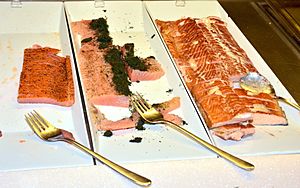
- Klippfisk – Cod fish that has been preserved by drying after salting.
- Lutefisk – Dried whitefish (usually cod) that has been treated with lye. It has a jelly-like texture and is a traditional Christmas dish. It's served with boiled potatoes, mashed green peas, melted butter, and small pieces of fried bacon.
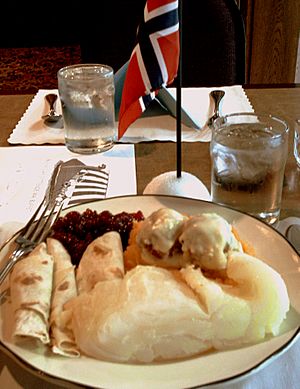
- Rakfisk – A fish dish made from trout or char, salted and left to ferment for a few months. It's eaten without cooking and has a strong smell and salty taste.
- Røkt laks – Smoked salmon, usually a fillet that has been cured and then hot or cold smoked.
- Spekesild – Salted Atlantic herring. A traditional dish with salted herring is served with boiled potatoes, raw onions, dill, pickled beetroots, and flatbread.
- Sursild – Pickled herring, a traditional dish with cured herring, onions, and spices in a brine. It's eaten as a snack, dinner, or topping on bread.
- Torsk – Cod fish. It's often poached and served simply with boiled potatoes and melted butter. Carrots, fried bacon, roe (fish eggs), and cod liver can also be served with it.
Grains, Soups, and Vegetables
These dishes are often hearty and comforting.
- Grøt – Porridge, made by heating or boiling grains in milk or water. It's often topped with sugar, honey, or fruit.
- Byggrynsgrøt – Porridge made with barley, milk, and water, often topped with cinnamon, honey, and berries.
- Havregrøt – Oatmeal porridge, usually boiled in water or milk, with salt. It's often served hot with berries, nuts, and sugar.
- Risengrynsgrøt – A hot dish made from rice and milk, served with butter, sugar, and cinnamon, especially around Christmas.
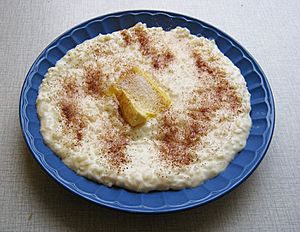
-
- Rømmegrøt – A thick, sweet porridge made with sour cream, whole milk, wheat flour, butter, and salt. It's usually drizzled with butter and sprinkled with sugar and cinnamon. It's very rich!
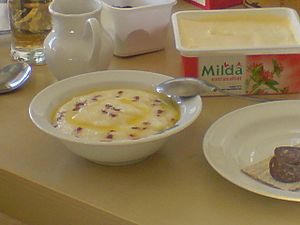
- Ertesuppe – Pea soup, traditionally served in springtime and at Easter, with potatoes, carrots, and other vegetables.
- Raspeball – A traditional Norwegian potato dumpling. It's made from grated or ground peeled potatoes mixed with flour. It can be served with salted and boiled pork or lamb meat, bacon, sausages, melted butter, and puréed rutabaga.
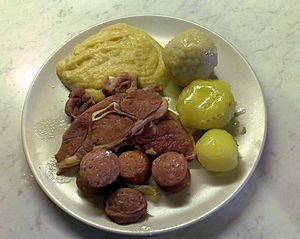
Dairy Delights
Norway is famous for its dairy products, especially its unique cheeses.
- Brunost – (Brown cheese) – A caramelized brown Norwegian whey cheese. It's one of Norway's most famous foods and is a big part of Norwegian culture.
- Gudbrandsdalsost – A type of brunost that includes goat milk.
- Gamalost – A traditional cheese made from skimmed cow's milk. It has a strong, sharp taste.
- Gomme – A traditional sweet cheese, usually served as a spread or dessert. It's made from milk that has been boiled for a long time, giving it a yellow or brown color. It can be used on bread, lefse, or waffles.
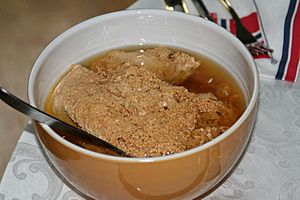
- Pultost – A soft, mature sour milk cheese flavored with caraway seeds.

- Rømme – Norwegian sour cream, made from cream or a mix of milk and cream that has been soured. It's thick and sour, used in many dishes, and sometimes with pancakes and waffles.
- Skyr – A cultured dairy product, like a thick yogurt but with a milder flavor. It's a type of fresh sour milk cheese.
Side Dishes and Sauces
These add flavor and complete a Norwegian meal.
- Brun saus – Brown sauce, a smooth sauce made from wheat flour, fat (like butter), water, and spices. It's used for many dishes like pork chops, meatballs, and fried fish or meat.
- Eggerøre – Scrambled eggs, often served for breakfast or lunch, and a common side dish at Christmas breakfast.
- Kålrabistappe – Puréed rutabaga (swede) mixed with water, heavy cream, butter, salt, and pepper. It's a popular side, especially with meat.
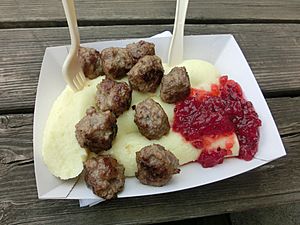
- Potetstappe – Mashed potatoes with added milk, butter, salt, and pepper. It's usually served as a side dish with meat and vegetables.
- Rødkål – Red cabbage, slowly cooked like surkål. It's served with pork, duck, turkey, and especially with Christmas food.

- Surkål – A traditional side dish made from finely sliced cabbage, slowly cooked with caraway and cumin seeds, apple, vinegar, sugar, salt, and butter. It's usually served with pork.
- Tyttebærsyltetøy – Lingonberry jam, made with berries, sugar, and a little water. It's often served with meat dishes like meatballs or liver.
- Vegetables – Common vegetables served as sides include potatoes, carrots, peas, rutabaga, cabbage, and Brussels sprouts.
Drinks to Try
From traditional to festive, Norway has a variety of drinks.
- Julebrus – A soft drink brewed by most Norwegian breweries as a Christmas drink, especially for kids. It can be sparkly red (strawberry/raspberry) or pale brown, depending on the brand.
- Juleøl – Christmas beer, a seasonal beer brewed for Christmas. It's often strong and spiced with cinnamon, orange peel, cloves, and vanilla.
- Karsk – A drink from the Trøndelag region, made with coffee and sometimes a spoon of sugar.
- Most – Freshly crushed fruit juice, usually apple juice, which is very popular in Norway.
- Saft – A concentrated syrup used to make drinks. It's usually fruit-flavored, made from fruit juice, water, and sugar. Blackcurrant is a popular flavor in Norway.
- Øl – Beer has a long history in Norway, made from fermented grains like barley.
Sweet Treats and Desserts
Norwegian desserts are often rich, creamy, and perfect for special occasions.
- Bløtkake – A layer cake with sponge cake, cream or custard, and fresh fruit. It's often served in summer or on Constitution Day.

- Byggrynskrem – A barley-based cream dessert, usually served with berries and apple juice.
- Dronning Mauds pudding – (Queen Maud's pudding) – A dessert mostly made of cream, eggedosis (whipped eggs and sugar), and chocolate. It's named after Queen Maud of Norway.
- Eggedosis – A dessert made from sugar and eggs, whipped into a fluffy cream. It's a simple dessert that can have vanilla, cocoa, or berries. It's a Norwegian tradition to serve it on Constitution Day.
- Fastelavnsbolle – A traditional sweet roll. It's a cardamom-spiced wheat bun with its top cut off, filled with whipped cream and jam, and dusted with powdered sugar. They are served on Shrove Sunday.
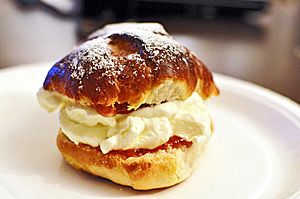
- Fattigmann – (Poor Man's Cookies) – A Christmas pastry made with eggs, sugar, cream, wheat flour, cardamom, and cognac. The dough is deep-fried.

- Fyrstekake – (Prince's Cake) – A cake with shortcrust pastry and an almond or marzipan filling. It often has a lattice pattern on top and is served during Christmas with coffee or tea.
- Goro – A traditional sweet bread, pressed flat and often flavored with cardamom. It's like a mix between a cookie, cracker, and waffle.
- Ingefærnøtter – Ginger cookies, known for their spiced taste with ginger, cinnamon, nutmeg, cardamom, and black pepper. They are often baked at Christmastime.
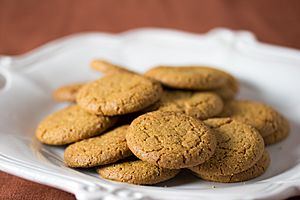
- Julekake – (Christmas Cake) – A Christmas yeast cake with butter, sugar, cardamom, candied fruits, raisins, and almonds. It can be eaten warm or toasted with butter.
- Kransekake – (Wreath Cake) – A traditional Danish and Norwegian cake, often eaten on special occasions like Constitution Day, Christmas, weddings, and baptisms. It's made of stacked rings of almond cake.
- Kransekakestenger – Bite-sized versions of the kransekake, often made for Christmas.
- Krumkake – A thin waffle cookie made from flour, butter, eggs, sugar, and cream. They can be eaten plain or filled with whipped cream or other fillings.
- Kvæfjordkake – A sponge cake baked with meringue, vanilla cream, and almonds. It's often seen at birthdays and family celebrations.
- Lussekatt – A type of yeast bun, mostly baked for St. Lucia's Day on December 13th. They are S-shaped and yellow from saffron, sometimes decorated with raisins.
- Marsipan – A sweet treat made mainly from sugar, honey, and ground almonds.
- Marsipangris – (Marzipan Pig) – At Christmas, a tradition is to hide an almond in rice porridge. Whoever finds it gets a marzipan pig as a prize!
- Marsipankake – A dessert with layers of sponge cake, vanilla cream, jams, and other fillings, topped with a layer of marzipan.
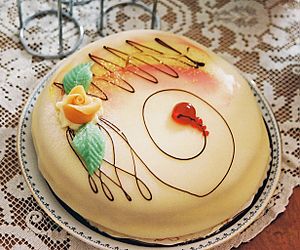
- Multekrem – A traditional Norwegian dessert made by mixing cloudberries with whipped cream and sugar. It's often served with krumkake or kransekake and is a common Christmas dessert.
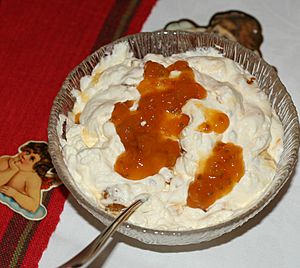
- Pepperkake – Gingerbread cookies, most often eaten around Christmas. They are spiced with cinnamon, cloves, ginger, and cardamom.
- Pepperkakehus – (Gingerbread House) – A traditional pastry made from baked gingerbread, decorated with icing. Kids often crush and eat them after Christmas.
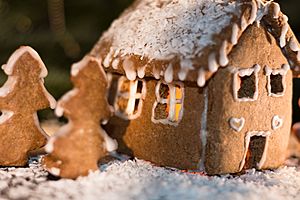
- Riskrem – A dessert made from cold rice porridge, sugar, vanilla sugar, and whipped cream. It's served cold, often with warm red berry sauce. It's common to hide a whole almond in it; whoever finds it gets a small gift.
- Sandbakelse or Sandkake – A type of sugar cookie often served at Christmas. They are made with flour, ground almonds, butter, eggs, and sugar, and baked in fluted tins.
- Serinakaker – A butter cookie with flour, sugar, and eggs, topped with pearl sugar. They are like shortbread and served around Christmastime.
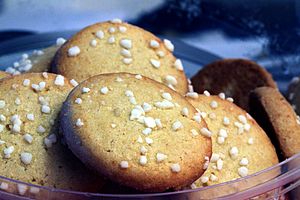
- Skolebrød – (School Bread) – A sweet roll made from yeast dough, filled with custard, and decorated with icing dipped in grated coconut.
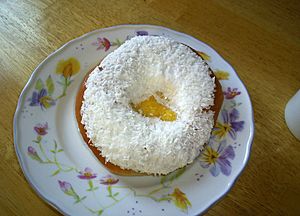
- Smultring – (Doughnut Rings) – Small, ring-shaped cake doughnuts, usually without glaze or filling. They are often spiced with cardamom, cinnamon, or lemon zest.

- Tilslørte bondepiker – (Veiled Peasant Girls) – A traditional dessert served in clear glasses or bowls. It has layers of mashed apples (or other fruit), whipped cream, and toasted breadcrumbs or rusk crumbs.
Images for kids


